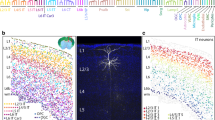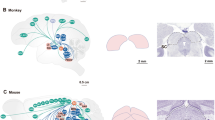Summary
Volleys in group I and II fibers of muscle nerves and group II fibers of cutaneous, joint and fascial nerves have evoked CF responses in the anterior lobe of the cerebellum. In the pars intermedia there is a fairly sharp somatotopic localization of the forelimb CF responses to the Vth lobule (Larsell) and the hindlimb to the IVth and IIIrd lobules. In the vermis there is much more admixture, with the hindlimb-evoked responses tending to dominate in the lateral vermis of the Vth lobule, and the forelimb more medially. In the IVth and IIIrd lobules forelimb responses were rare and were never large. In the medial vermis up to 1–1.7 mm from the midline there were no CF-evoked responses from the limb nerves. These distributions of CF-evoked responses are remarkably different from those reported by Oscarsson, and consideration is given to the factors responsible for this discrepancy.
A more detailed examination was made of the CF-evoked responses from a large variety of hindlimb and forelimb nerves. Observations were made along many tracks usually arranged in a transverse plane, and it was found that between different recording sites along the same track or along adjacent tracks, there was a great deal of variation in the relative magnitudes of the CF-evoked responses from the different nerves. These distributions have an ill-defined patchy character so that at any focus there is opportunity for the most diverse kinds of piecemeal integration.
These findings on the CF-input are considered in relationship to the mossy fiber input. It is pointed out that the pathways conveying CF-input to the cerebellum have a level of discriminative input adequate for the operation of fine control.
Similar content being viewed by others
References
Adrian, E.D.: Afferent areas in the cerebellum connected with the limbs. Brain 66, 289–315 (1943).
Armstrong, D.M., and R.J. Harvey: Responses of a spino-olivo-cerebellar pathway in the cat. J. Physiol. (Lond.) 194, 147–168 (1968).
—, J.C. Eccles, R.J. Harvey and P.B.C. Matthews: Responses in the dorsal accessory olive of the cat to stimulation of hind limb afferents. J. Physiol. (Lond.) 194, 125–145 (1968).
Bessou, P., et Y. Laporte: Étude des récepteurs musculaires innervés par les fibres afférentes du groupe III (fibres myelinisées fines), chez la chat. Arch. ital. Biol. 99, 293–321 (1961).
Brodal, A., F. Walberg and T. Blackstad: Termination of spinal afferents to inferior olive in cat. J. Neurophysiol. 13, 431–454 (1950).
Brown, A.G., and A. Iggo: A quantitative study of cutaneous receptors and afferent fibres in the cat and rabbit. J. Physiol. (Lond.) 193, 707–733 (1967).
Burgess, P.R., and E.R. Perl: Myelinated afferent fibres responding specifically to noxious stimulation of the skin. J. Physiol. (Lond.) 190, 541–562 (1967).
Combs, C.M.: Electro-anatomical study of cerebellar localization. Stimulation of various afferents. J. Neurophysiol. 17, 123–143 (1954).
Dow, R.S.: Cerebellar action potentials in response to stimulation of various afferent connections. J. Neurophysiol. 2, 543–555 (1939).
—, and R. Anderson: Cerebellar action potentials in response to stimulation of proprioceptors and enteroceptors in the rat. J. Neurophysiol. 5, 363–371 (1942).
—, and G. Moruzzi: The physiology and pathology of the cerebellum. Minneapolis: University of Minnesota Press (1958).
Eccles, J.C.: Circuits in the cerebellar control of movement. Proc. natl. Acad. Sci. (Wash.) 58, 336–343 (1967).
—, R. LlinÁs and K. Sasaki: The excitatory synaptic action of climbing fibres on the Purkinje cells of the cerebellum. J. Physiol. (Lond.) 182, 268–296 (1966).
—, L. Provini, P. Strata and H. Táboříková: Patterns of climbing fiber input to the cerebellar anterior lobe. Brain Res. 5, 425–430 (1967).
—: Analysis of electrical potentials evoked in the cerebellar anterior lobe by stimulation of hindlimb and forelimb nerves. Exp. Brain Res. 6, 171–194 (1968).
Grant, G.: Projection of the external cuneate nucleus onto the cerebellum in the cat. An experimental study using silver methods. Exp. Neurol. 5, 179–195 (1962a).
—: Spinal course and somatotopically localized termination of the spinocerebellar tracts. An experimental study in the cat. Acta physiol. scand. 56, Suppl. 193 (1962b).
Hunt, C.C., and A.K. mcintyre: An analysis of fibre diameter and receptor characteristics of myelinated cutaneous afferent fibres in the cat. J. Physiol. (Lond.) 153, 99–112 (1960).
Ito, M., K. Obata and R. Ochi: The origin of cerebellar-evoked inhibition of Deiters neurones. II. Temporal correlation between the trans-synaptic activation of Purkinje cells and the inhibition of Deiters neurones. Exp. Brain Res. 2, 350–364.
Kitai, S.T., H. Táboříková, N. Tsukahara and J.C. Eccles: Discriminative patterns for cutaneous input to the cerebellar anterior lobe. Fed. Proc. 27, 518 (1968).
Laporte, Y., et P. Bessou: Innervation afférente du muscle strié. Actual. Neurophysiol. 1, 189–201 (1959).
Oscarsson, O.: Termination and functional organization of a dorsal spino-olivo-cerebellar path. Brain Res. 5, 531–534 (1967).
—: Functional significance of information channels from the spinal cord to the cerebellum. In: Neurophysiological basis of normal and abnormal motor activities. Ed. by M.D. Yahr and D.P. Purpura. Hewlett, N.Y.: Raven Press (1968a).
Oscarsson, O.: Termination and functional organization of the ventral spino-olivo-cerebellar path. In preparation (1968b).
—, and N. Uddenberg: Somatotopic termination of spino-olivo-cerebellar path. Brain Res. 3, 204–207 (1966).
Paintal, A.S.: Functional analysis of group III afferent fibres of mammalian muscles. J. Physiol. (Lond.) 152, 250–270 (1960).
—: Participation by pressure-pain receptors of mammalian muscles in the flexion reflex. J. Physiol. (Lond.) 156, 498–514 (1961).
Provini, L., S. Redman and P. Strata: Somatotopic organization of mossy and climbing fibres to the anterior lobe of cerebellum activated by the sensorimotor cortex. Brain Res. 6, 378–381 (1967).
—: Mossy and climbing fiber organization on the anterior lobe of the cerebellum activated by forelimb and hindlimb areas of the sensorimotor cortex. Exp. Brain Res. 6, 216–233 (1968).
Snider, R.S., and A. Stowell: Receiving areas of the tactile, auditory and visual systems in the cerebellum. J. Neurophysiol. 7, 337–357 (1944).
Author information
Authors and Affiliations
Rights and permissions
About this article
Cite this article
Eccles, J.C., Provini, L., Strata, P. et al. Topographical investigations on the climbing fiber inputs from forelimb and hindlimb afferents to the cerebellar anterior lobe. Exp Brain Res 6, 195–215 (1968). https://doi.org/10.1007/BF00235124
Received:
Issue Date:
DOI: https://doi.org/10.1007/BF00235124




